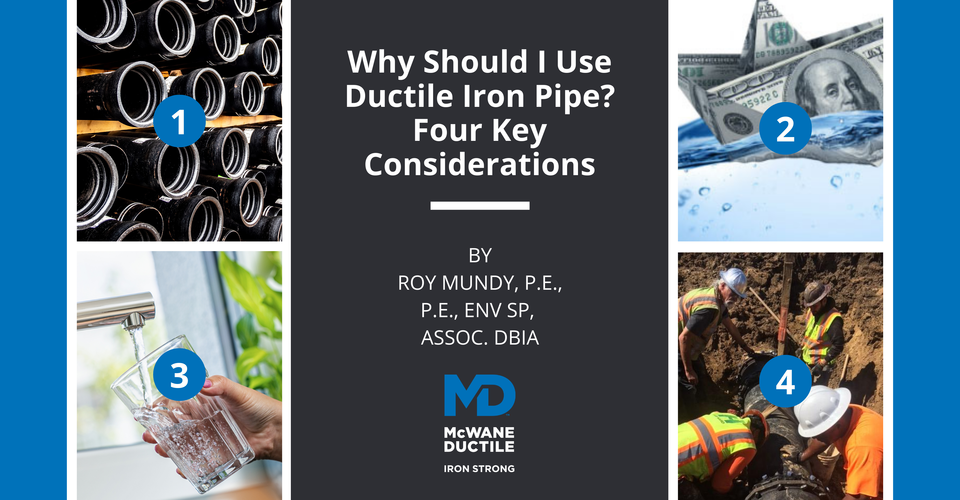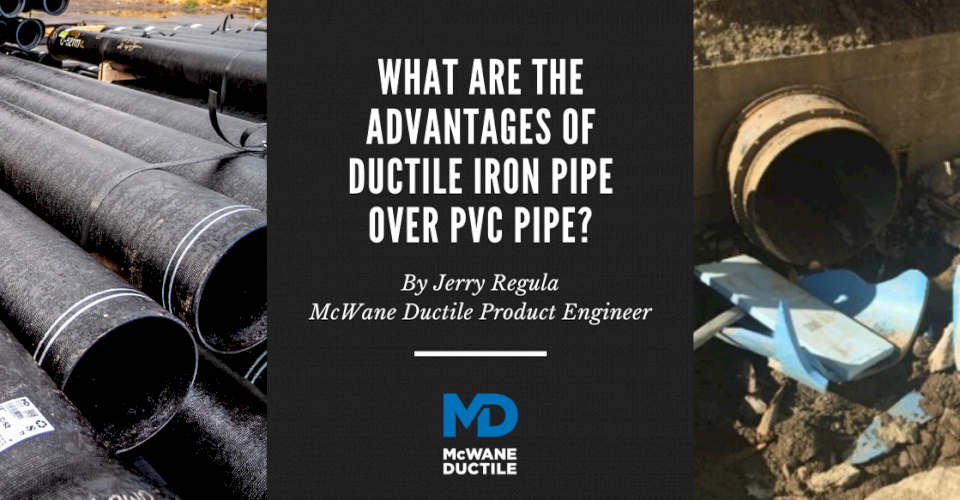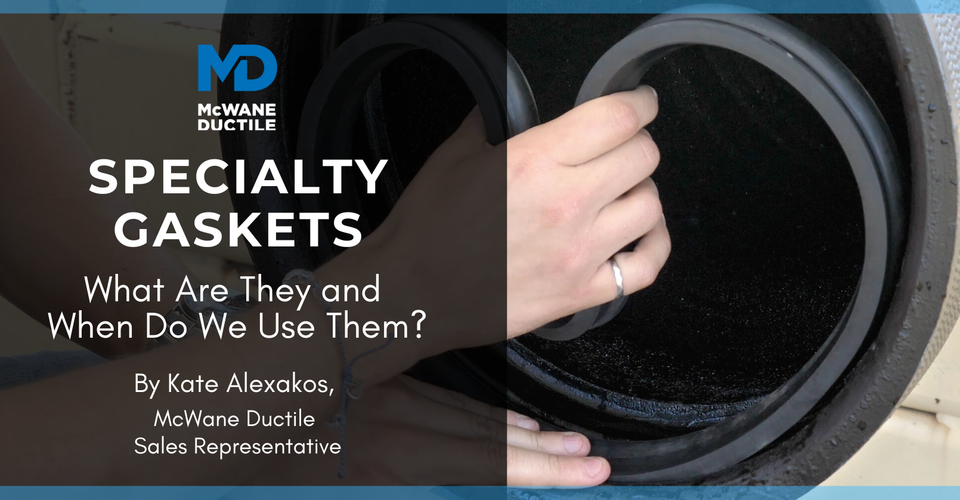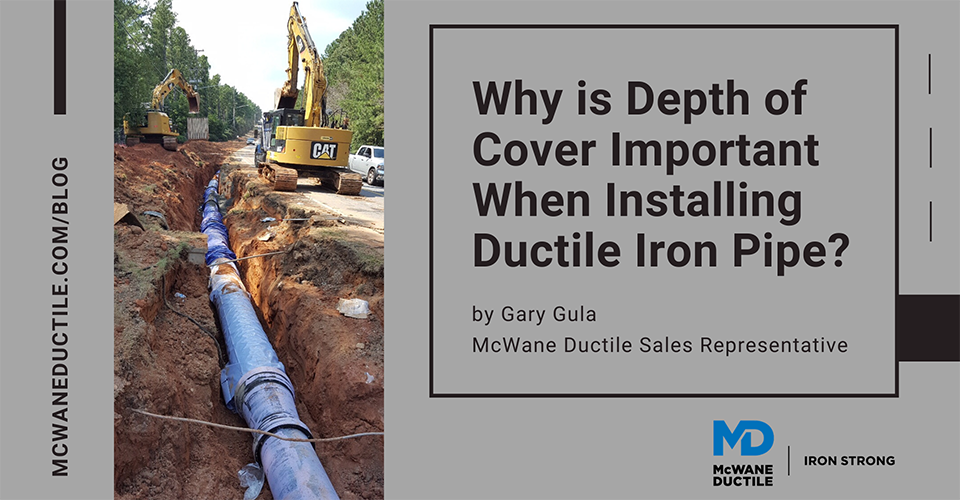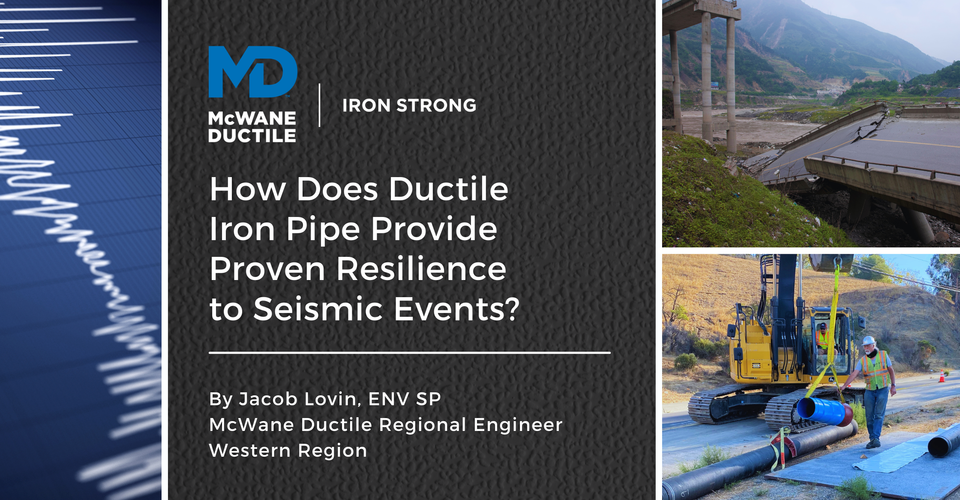-
HDPE and DI Pipe - Differences That Matter - A Comparative Narrative
11/22/2019 In Installation TechnicalWhen choosing an appropriate utility piping material for your water or wastewater project, there is so much more to consider than just the purchase price alone. This comparison between two popular piping materials – HDPE and Ductile iron pipe – demonstrates the need for more than just a cursory review or habitual choice. At McWane Ductile, we are always available to run through the matrix with you. Some installations or conditions do favor alternate materials, yet it’s hardly ever a cut-and-dried deal. Let’s take a closer look to find out why.
-
Why Should I Use Ductile Iron Pipe? Four Key Considerations
02/28/2019 In Environmental & Safety Installation Technical“Why should I use Ductile iron pipe?”
The question is ostensibly meant to include “instead of other types of piping material.” Well, the reasons are vast and vary depending on project requirements. Since we aren’t talking about a specific project, we’ll look at the general overriding reasons Ductile iron pipe is the best choice for your piping projects.
-
What Are The Advantages of Ductile Iron Pipe Over PVC Pipe?
06/18/2020 In Installation Products TechnicalQuestion – What is the difference between Ductile Iron and Polyvinyl Chloride (PVC)?
Answer – Many things, but some groups may attempt to “muddy the waters” with inaccurate information regarding the two materials.With the information that follows, we will take a closer look at what really separates Ductile Iron from PVC and why it matters.
-
What is Tuberculation and Why Did it Happen in Iron Pipe?
04/13/2023 In Products TechnicalIn years past, gray cast iron pipe was originally sold with no lining or coating on the pipe's interior. After many years of study, it became apparent that the inside of cast iron pipe might be affected by certain types of water. In this Iron Strong Blog, we will describe tuberculation, why it happened in older iron pipe, and the modern solution for tuberculation.
-
Specialty Gaskets: What Are They and When Do We Use Them?
12/07/2023 In Installation Products TechnicalIn the realm of Ductile iron pipe (DI pipe) joints, standard SBR (Styrene Butadiene) gaskets are the traditional watertight sealing solution. However, did you know these gaskets are not intended for all applications? When dealing with unique jobs, selecting the proper gasket material catering to specific operational demands is essential. There are specialized gaskets, distinct in composition and functionality, that transcend the conventional capabilities of SBR gaskets. Each gasket described below is made for specific purposes based on factors like soil conditions, fluid temperature, or powerful industrial forces. These gaskets utilize modern elastomers to withstand the demands of any given project. In this #IronStrong Blog, we will closely examine each gasket available for your pipeline project.
Today’s modern push-on gaskets are comprised of different types of rubber compounds, and the development of the push-on gasket has proven to be instrumental to the success of the leak-free water and sewer joint. Let's take a closer look at each specialty gasket available on the market today.
-
Why Do Ductile Iron Pipe Lengths Vary?
04/04/2020 In Installation Products TechnicalI have been on the road for nearly 20 years, talked with numerous contractors and distributors during that time, and there is a common question that I often get asked, "Why do Ductile iron pipe lengths vary?"
-
What Are The Benefits of DI Pipe vs. Concrete Cylinder Pipe?
09/02/2020 In ProductsPrestressed Concrete Cylinder Pipe (PCCP) has been used in water and wastewater applications for nearly 80 years. The thought process behind PCCP was sound, in that it would combine concrete's high compressive strength with steel's high tensile strength. However, like many products, PCCP has continued to fall short in the following years in many comparative categories to Ductile iron.
-
Why is Depth of Cover Important When Installing Ductile Iron Pipe?
12/20/2019 In Installation TechnicalWithin this article, we will discuss Depth of Cover and the key factors to consider when selecting the type of trench (or laying condition) for your application. We’ll also discuss why it is important to choose the correct trench application, not only for today, but for future adjustments or improvements that are planned for the surrounding area where the pipeline is being installed.
-
What are Some Top FAQs on Ductile Iron Pipe?
09/13/2021 In Installation Products TechnicalAs a manufacturer of Ductile iron pipe (DI pipe), we often field questions from water professionals regarding DI pipe, its uses, and how to install it properly. We even receive numerous questions about alternate materials, their differences, their uses, and the best choice for the application. And of course, when you ask, we answer…honestly, even when the answer doesn’t include Ductile iron. In this Iron Strong Blog, we’ll cover a few of our frequently asked questions (FAQ) and provide some solutions. We will continue with this FAQ series in the upcoming months.
-
V-Bio® Or Cathodic Protection – An Honest Comparison
12/13/2019 In Installation Products TechnicalOdds are you may not be a certified corrosion specialist or an expert in the corrosion field for that matter. Most engineers that are responsible for specifying water projects are not. There are of course engineers who dedicate their entire careers to the subject. The good news is that McWane Ductile is committed to excellence in the corrosion field and provides professionals to assist you with making sound decisions regarding corrosion control.
Latest Posts
- Developing an Asset Management Plan for Your Future Utility or Engineering Organization 12/04/2025 In Comparisons Industry
- Can Joining Water Works Industry Organizations Help You Grow Professionally? 10/21/2025 In Careers WaterWorks
- How Does Ductile Iron Pipe Provide Proven Resilience to Seismic Events? 09/04/2025 In Products Resiliency Technical
- How to Secure Green Reserve Sustainability Incentives Using State Revolving Funding & Ductile Iron Pipe 07/29/2025 In Energy Products Technical


